The advantage of having good dynamic range
Jun 11, 2016 16:05:01 #
Jun 11, 2016 18:45:13 #
My .02,
Where I come from, since the dawn of the digital era, most people I know were underexposing to ensure acceptable highlight detail - then along came raw and the ETTR B.S. - I do not shoot raw so I do not worry about ETTR - and tend to be on the underside especially if I am concerned about highlights.
If I were to shoot the scene you posted, I would be using a SONY with EVF and JPEG, if there were not a lot of action to be stopped, I would try to use the in camera HDR rapid 3- exposure combination - but if there were critical action to be stopped, I would use a HDR sensor ( full frame) and lean towards underexposure - as you have done here.
Where I come from, since the dawn of the digital era, most people I know were underexposing to ensure acceptable highlight detail - then along came raw and the ETTR B.S. - I do not shoot raw so I do not worry about ETTR - and tend to be on the underside especially if I am concerned about highlights.
If I were to shoot the scene you posted, I would be using a SONY with EVF and JPEG, if there were not a lot of action to be stopped, I would try to use the in camera HDR rapid 3- exposure combination - but if there were critical action to be stopped, I would use a HDR sensor ( full frame) and lean towards underexposure - as you have done here.
Jun 11, 2016 19:07:12 #
Jun 11, 2016 21:42:35 #
Very interesting Toby, thanks for sharing you knowledge with us.
kymarto wrote:
I'm just going through a bunch of photos for my we... (show quote)
Jun 11, 2016 22:08:16 #
imagemeister wrote:
My .02, br br Where I come from, since the dawn o... (show quote)
I will never shoot jpg--just too limited in processing options re: color and luminance correction. I always shoot raw and work in 16 bit.
Jun 11, 2016 22:36:11 #
kymarto wrote:
I will never shoot jpg--just too limited in processing options re: color and luminance correction. I always shoot raw and work in 16 bit.
yes, I know the mind set ....
Jun 12, 2016 07:04:42 #
kymarto wrote:
I'm just going through a bunch of photos for my website, and I ran across a bracket series I did last year in Hong Kong ...
Great example! There is indeed a good deal of useful information in the lower reaches of the dynamic range that can be recovered with little noise.
Just for grins, I looked up the recommended exposure for a brightly lit street scene at https://en.wikipedia.org/wiki/Exposure_value At ISO 100 it recommends an EV of 7-8. That is an EV of 9-10 for ISO 400.
An EV of 9-10 equates to an exposure of 1/30 at f/4-5.6 so your -3 EC (1/30 @ F/4.5) is actually the exposure you might have chosen if you ignored the camera's meter.
Jun 12, 2016 07:30:18 #
kymarto wrote:
Clipped highlights are not "recoverable", they are gone forever. I imagine what you are talking about is the difference between the JPEG Histogram shown by the camera and the Raw Histogram which is conspicuous by its absence.If some folks want to lose highlights in preference to somewhat noisy shadows that is certainly their prerogative; however it seems rather counterintuitive to me. Consider that at best one can recover 1.5 EV of clipped highlights, while with a good sensor, it is possible to bring up shadows at least 3EV with minimal added noise in the shadows.
Until the Manufacturers relent and give us a proper Raw Histogram, it's up to the User to find how much headroom is available before clipping occurs, then you can meter the highlights and dial down the appropriate number of EVs, probably about -3EV in your case.
kymarto wrote:
You can take out the guesswork if you determine the "highlight headroom" of your camera.I certainly do not advocate underexposure as an optimal practice for image quality, but the fact is that meters often ignore highlights. In many situations I make it a standard practice to underexpose by 1 EV, or more if I find on review that highlights are still being clipped. I have lost too many one-chance shots to blown highlights to worry too much about a bit of extra noise in the shadows.
kymarto wrote:
Understood and that is the choice we face; do I expose for the highlights or do I expose for the shadows. Whichever you choose results in a correct exposure for that situation.To be clear, this is usually in situations of extreme dynamic range, especially shooting against the light, or if I want to preserve a sunny sky while my subject is in shadow. If I am shooting a normal front lit scene I do not underexpose.
Jun 12, 2016 12:35:21 #
joseph premanandan wrote:
my understanding of HDR is you take three to five ... (show quote)
Multibracket HDR is useful whenever the dynamic range of the scene exceeds the dynamic range of the sensor. There is no hard and fast rule as to the number of brackets nor as to the EV steps between brackets. The rule is this: the darkest frame should have no clipped highlights, or at least none that you hope to have detail in (you'll never get the sun not to clip) and the lightest frame should have the deepest shadows exposed as dark midtones. However many frames you need to do that is the right number; more make no sense. The dark frame is actually more important than the light frame: clipped highlights in HDR are unrecoverable, while you can bring up dark shadows, but at the expense of noise.
In my HDR work, I've sometimes had to shoot 15 frames (middle exposure and +-7EV, brackets 1EV apart). As long as you have a middle frame that has good midtones, you can actually use steps of 3EV, although I always think 2EV steps are safer. When I need to deghost, I use all the frames, as the 1 EV steps give me more options for the areas to be deghosted.
Here are a few of my more extreme HDRs, shot both just after the tsunami and two years later in the exclusion zone around Fukushima. These were just not possible with a single frame because of the extreme DR, but if your scene DR does not exceed your sensor DR, I strongly recommend not doing multibracket HDR for the "HDR look", which can be achieved much more easily using some standard post-processing techniques.
A bus wrapped around a building in Natori. Moderate HDR +-2EV
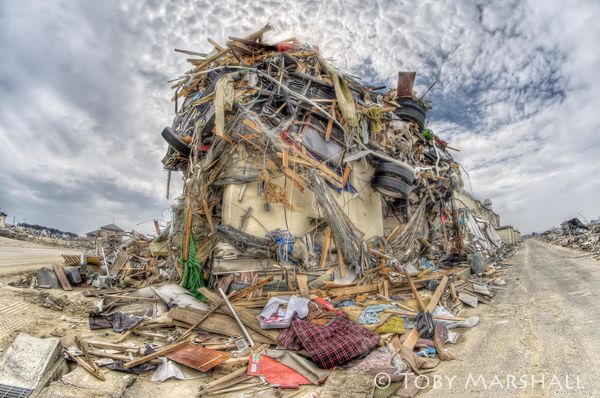
(Download)
A ship washed 2 kilometers inland, fairly extreme HDR +-4EV
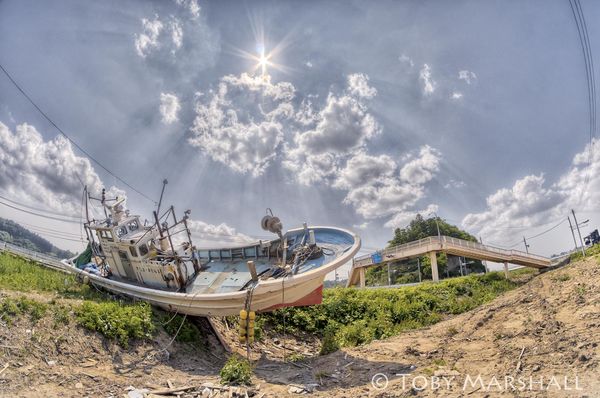
(Download)
Front room in a small hotel, Tomioka two years after the trunami and the town's abandonment moderate HDR +-3EV
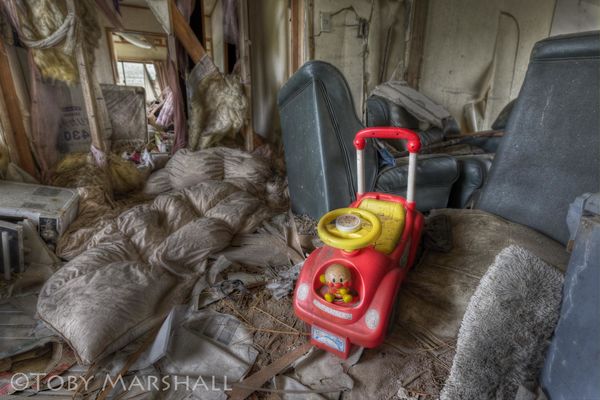
(Download)
Truck washed into living room, 2 years later. Extreme HDR (the room was completely dark) +-6EV
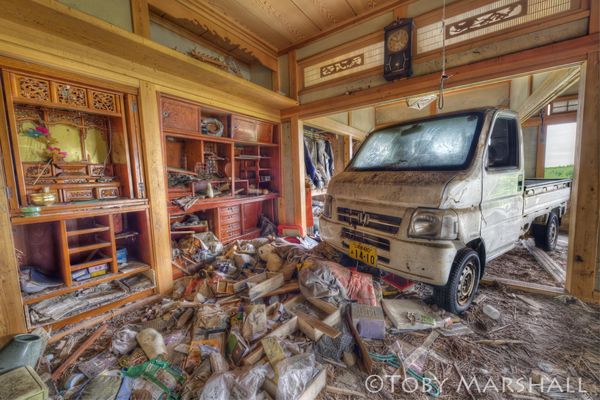
(Download)
Abandoned pachinko parlor in Tomioka, two years later. Exxtreme HDR +-7EV
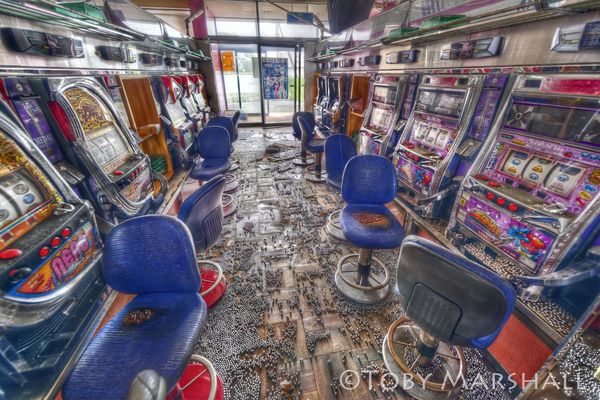
(Download)
Jun 13, 2016 05:55:14 #
Jun 13, 2016 06:38:09 #
lukan
Loc: Chicago, IL
I love the subject matter, the composition, the detail and the color in each of those pictures. +-7EV! What gets! Good stuff, sir.
If you want to reply, then register here. Registration is free and your account is created instantly, so you can post right away.





